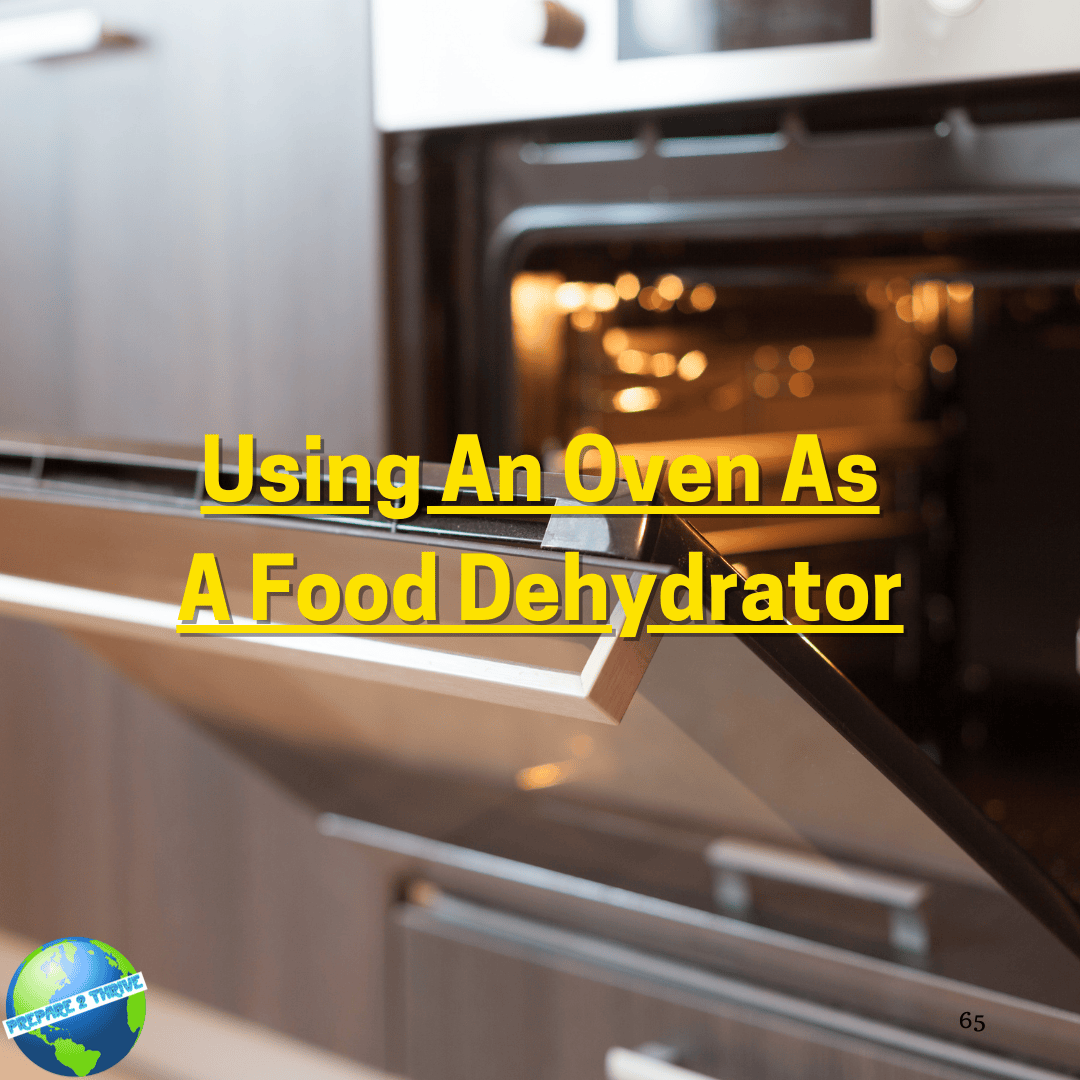Dehydration and Why It's Useful
Dehydration is the process of removing water from food to extend its shelf life and preserve its nutrients. Water is an essential ingredient for the growth of microorganisms that cause spoilage, so by removing it from food, we can prevent bacterial growth and spoilage. Dehydrating food also makes it more portable and convenient for storage and transport.
Dehydration is useful because it allows you to store food for longer periods of time without the need for refrigeration or freezing. This is particularly useful for outdoor enthusiasts, hikers, and campers who need lightweight, non-perishable food options. Additionally, dehydrated food is a great option for emergency preparedness kits or for those who live in areas prone to natural disasters where power outages can disrupt the food supply chain.
In addition to the practical benefits, dehydrated foods are also packed with nutrients. The dehydration process preserves the vitamins, minerals, and enzymes in food, making it a healthy and nutritious option. Dehydrated fruits and vegetables, for example, are rich in fiber, antioxidants, and other essential nutrients.
Overall, dehydration is a useful and practical way to preserve food while maintaining its nutritional value, making it an increasingly popular choice for home cooks and outdoor enthusiasts alike.
Using An Oven As A Dehydrator
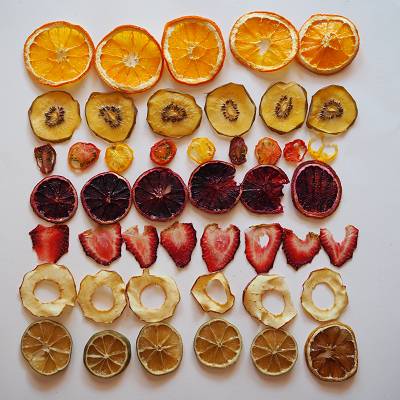 When it comes to dehydrating food, most people think of using specialized equipment like a food dehydrator or a dedicated dehydrating oven. However, did you know that you can use your regular kitchen oven to dehydrate food? Using an oven as a dehydrator is a simple and cost-effective way to dry out fruits, vegetables, meats, and herbs. It's a great option for those who want to try dehydrating food at home but don't want to invest in a dedicated appliance. In this article, we'll explain how to use your oven as a dehydrator, from selecting the right oven to preparing and dehydrating your food.
When it comes to dehydrating food, most people think of using specialized equipment like a food dehydrator or a dedicated dehydrating oven. However, did you know that you can use your regular kitchen oven to dehydrate food? Using an oven as a dehydrator is a simple and cost-effective way to dry out fruits, vegetables, meats, and herbs. It's a great option for those who want to try dehydrating food at home but don't want to invest in a dedicated appliance. In this article, we'll explain how to use your oven as a dehydrator, from selecting the right oven to preparing and dehydrating your food.
The Benefits Of Using An Oven As A Dehydrator
Cost Savings
Using an oven as a dehydrator can save you money in several ways.
Firstly, as mentioned earlier, it eliminates the need for a dedicated dehydrating appliance, which can be expensive to purchase and maintain. An oven is a common household appliance that most people already have in their kitchens, making it a more affordable option.
Secondly, using an oven as a dehydrator can help you save money on food waste. Dehydrating food is a great way to use up surplus fruits, vegetables, and meats that might otherwise go bad before you have a chance to eat them. By dehydrating them, you can extend their shelf life and reduce the need to throw them away.
Finally, dehydrated food is a cost-effective and healthy snack option. Store-bought dehydrated fruits and vegetables can be quite expensive, but by dehydrating your own food at home, you can save money while enjoying the nutritional benefits of dried fruits and veggies. Plus, you can experiment with different flavor combinations and seasonings to create a customized snack that suits your taste preferences.
Overall, using an oven as a dehydrator can be a cost-effective way to preserve food, reduce waste, and create healthy snacks at home.
Convenience
 Using an oven as a dehydrator is a convenient option for several reasons.
Using an oven as a dehydrator is a convenient option for several reasons.
Firstly, it eliminates the need for a separate dehydrating appliance, which can take up valuable counter space and require additional storage. With an oven, you can simply use an appliance that you already have in your kitchen.
Secondly, using an oven as a dehydrator allows you to dry out larger batches of food at once. Most food dehydrators have limited capacity, which can make it difficult to dehydrate larger quantities of food. With an oven, you can use multiple baking sheets and racks to dry out more food at once, making the process more efficient.
Thirdly, using an oven as a dehydrator allows you to easily adjust the temperature and time to suit different types of food. This can be particularly useful when dehydrating foods with different moisture levels or thicknesses. Most food dehydrators have a set temperature range, which can limit their versatility. With an oven, you can experiment with different settings to achieve the perfect level of dehydration for your food.
Overall, using an oven as a dehydrator is a convenient option for those who want to try dehydrating food at home without investing in a separate appliance. It allows you to dehydrate larger quantities of food, adjust the temperature and time settings, and use an appliance that you already have in your kitchen.
Consistency
Using an oven as a dehydrator can produce consistent results, but there are a few factors to consider to ensure that your food is evenly dehydrated.
Firstly, it's important to spread out your food in a single layer on a baking sheet or wire rack. If you pile up your food or overlap pieces, it can prevent air from circulating evenly around the food, resulting in uneven dehydration.
Secondly, it's important to rotate your baking sheets or racks periodically during the drying process. This will help ensure that each piece of food is exposed to the heat and airflow evenly, resulting in more consistent dehydration.
Thirdly, it's important to monitor the temperature and time carefully to prevent over or under-drying your food. Use a reliable thermometer to measure the temperature inside your oven and adjust the settings as needed. Check your food periodically to see if it's dry and adjust the time accordingly.
Overall, with proper technique and monitoring, using an oven as a dehydrator can produce consistent and evenly dried food. Just be sure to spread out your food, rotate the baking sheets or racks, and monitor the temperature and time carefully to achieve the best results.
Choosing the right oven
Convection vs Conventional
When it comes to using an oven as a dehydrator, you can use either a conventional or a convection oven. Both types of ovens can be effective for dehydrating food, but there are some differences to consider.
Conventional ovens are the most common type of oven found in households. They use heating elements located at the bottom and top of the oven to produce heat. This type of oven can be used for dehydrating food, but it may take longer than a convection oven due to the lack of a fan to circulate air. However, conventional ovens can be more affordable and may be sufficient for occasional dehydrating.
Convection ovens, on the other hand, use a fan to circulate hot air throughout the oven, which can speed up the drying process and produce more consistent results. This type of oven can be more expensive than a conventional oven but may be worth the investment if you plan on dehydrating food regularly.
When choosing the right oven for dehydrating food, consider your budget, the frequency of use, and your desired results. If you plan on dehydrating food frequently or want to achieve more consistent results, a convection oven may be the better option. However, if you're just getting started or have a limited budget, a conventional oven may be sufficient.
Regardless of the type of oven you choose, be sure to monitor the temperature and time carefully to achieve the best results.
Temperature Range
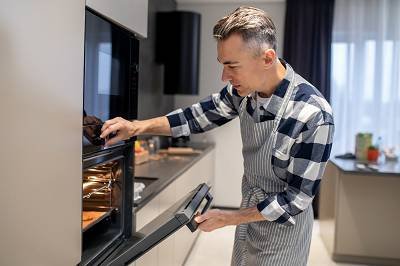 When using an oven as a dehydrator, the temperature range is an important factor to consider. The ideal temperature range for dehydrating food in an oven is typically between 60°C (140°F) and 70°C (160°F). This low temperature range is important for preserving the nutrients and flavor of the food while removing the moisture.
When using an oven as a dehydrator, the temperature range is an important factor to consider. The ideal temperature range for dehydrating food in an oven is typically between 60°C (140°F) and 70°C (160°F). This low temperature range is important for preserving the nutrients and flavor of the food while removing the moisture.
However, different types of food may require different temperature ranges. For example, herbs and fruits with high water content may require a lower temperature range, while meats and fish may require a higher temperature range to ensure food safety.
It's important to note that oven temperatures can vary, and some ovens may have temperature fluctuations that can affect the consistency of your dehydrated food. To ensure the most consistent results, use an oven thermometer to monitor the temperature inside your oven and adjust the temperature settings as needed.
In general, it's best to start with a lower temperature range and adjust as needed based on your results. Be sure to also monitor the drying time to ensure that your food is fully dehydrated without becoming over-dried and brittle. With proper monitoring and temperature control, you can achieve great results when using an oven as a dehydrator.
Size
When using an oven as a dehydrator, the size of your oven is an important consideration. The size of your oven will determine how much food you can dehydrate at once and can affect the overall drying time.
If you plan on dehydrating large quantities of food, you'll need an oven that can accommodate multiple trays or racks at once. Consider the dimensions of your oven and the size of the baking sheets or racks you plan on using to determine how much food you can dehydrate at once.
It's also important to leave space between each piece of food to ensure that air can circulate evenly around each item. Overcrowding the oven can cause some areas to dry more slowly or not at all, resulting in inconsistent dehydration.
If you have a smaller oven, you may need to dehydrate food in batches. This can increase the overall drying time but may be necessary to ensure that each piece of food is evenly dried.
In general, the size of your oven will affect the amount of food you can dehydrate at once and the overall drying time. Consider the dimensions of your oven and the amount of food you plan on dehydrating to ensure that you have enough space and time to achieve the best results.
Preparing your food for dehydration
Cleaning
Before dehydrating food in an oven, it's important to properly clean and prepare your food. This will help ensure that your food is safe to eat and that it dehydrates evenly.
Start by washing your fruits and vegetables under running water to remove any dirt or debris. For leafy greens, soak them in a bowl of water for a few minutes and then rinse them thoroughly to remove any dirt or sand. Pat your produce dry with a clean towel or paper towel to remove excess moisture.
For meats or fish, trim any excess fat or gristle and remove any bones or skin. Cut your food into thin, even slices or strips to ensure that they dry evenly.
It's important to handle your food safely during preparation to prevent cross-contamination. Wash your hands and all utensils, cutting boards, and other equipment with hot, soapy water before and after handling raw meat, poultry, or seafood.
Once your food is cleaned and prepared, arrange it in a single layer on a baking sheet or wire rack, making sure to leave space between each piece. This will allow for even airflow and help ensure that each piece of food dries evenly.
In summary, properly cleaning and preparing your food before dehydration is an important step to ensure safe and even drying. Wash your produce thoroughly, handle your food safely, and arrange it in a single layer on a baking sheet or wire rack. With proper preparation, you can achieve great results when using an oven as a dehydrator.
Slicing
 Slicing your food is an important step when preparing it for dehydration in an oven. Slicing your food into even pieces will help ensure that it dehydrates evenly and at the same rate.
Slicing your food is an important step when preparing it for dehydration in an oven. Slicing your food into even pieces will help ensure that it dehydrates evenly and at the same rate.
For fruits and vegetables, slice them into thin, uniform pieces using a sharp knife or mandoline. Aim for slices that are no thicker than ¼ inch (0.6 cm) to ensure that they dry thoroughly. Slicing your fruits and vegetables too thickly can result in longer drying times and uneven dehydration.
For meats and fish, slice them against the grain into thin strips or pieces. This will help tenderize the meat and ensure that it dries evenly. Aim for pieces that are no thicker than ¼ inch (0.6 cm) to ensure even drying.
When slicing your food, it's important to keep the size and thickness of the pieces consistent. This will help ensure that they dry at the same rate and are evenly dehydrated. If some pieces are thicker than others, they may take longer to dry, resulting in uneven dehydration.
In summary, slicing your food into even, uniform pieces is an important step when preparing it for dehydration in an oven. Aim for slices that are no thicker than ¼ inch (0.6 cm) and keep the size and thickness of the pieces consistent to ensure even drying. With proper slicing, you can achieve great results when using an oven as a dehydrator.
Spices and Seasoning
Adding spices and seasoning to your food before dehydrating it can add flavor and depth to your dehydrated snacks. However, it's important to keep in mind that some spices and seasoning can affect the drying process and the overall quality of the dehydrated food.
Dry spices and seasoning can be added directly to fruits, vegetables, and meats before drying. However, wet ingredients like marinades or sauces should be avoided as they can slow down the drying process and increase the risk of spoilage.
When using dry spices and seasoning, it's important to use them sparingly to avoid overpowering the flavor of the food. Keep in mind that the flavors of the spices and seasoning may become more concentrated during the dehydration process.
Some spices and seasoning that work well with dehydrated food include salt, black pepper, garlic powder, onion powder, cumin, paprika, and chili powder. You can experiment with different spices and seasoning to find the flavors that work best for your tastes.
In summary, adding spices and seasoning to your food before dehydrating it can add flavor and depth to your dehydrated snacks. Use dry spices and seasoning sparingly and avoid wet ingredients like marinades or sauces. Experiment with different spices and seasoning to find the flavors that work best for you. With proper seasoning, you can create delicious and flavorful dehydrated snacks using an oven as a dehydrator.
Setting up your oven for dehydration
Using Baking Sheets
When using an oven as a dehydrator, using baking sheets is an effective way to arrange your food and ensure even drying. Here are some tips for using baking sheets when dehydrating food in an oven:
-
Choose the right baking sheets: Use baking sheets that are flat and have a rim to prevent food from sliding off. Avoid using baking sheets that are warped or bent, as this can affect the evenness of the drying process.
-
Line the baking sheets: Line your baking sheets with parchment paper or silicone mats to prevent your food from sticking to the sheet. This will also make cleanup easier.
-
Arrange your food in a single layer: Spread your food out in a single layer on the baking sheet, making sure that there is enough space between each piece. This will allow for even airflow and help ensure that each piece of food dries evenly.
-
Leave the oven door slightly open: Leaving the oven door slightly open will help regulate the temperature and humidity in the oven, which can help speed up the drying process.
-
Rotate the baking sheets: Rotate the baking sheets halfway through the drying process to ensure that each piece of food dries evenly. This is especially important for larger pieces of food or for baking sheets that are positioned in areas of the oven that may have different temperatures.
In summary, using baking sheets is an effective way to arrange your food and ensure even drying when using an oven as a dehydrator. Choose the right baking sheets, line them with parchment paper or silicone mats, arrange your food in a single layer, leave the oven door slightly open, and rotate the baking sheets halfway through the drying process. With these tips, you can achieve great results when using an oven as a dehydrator.
Adjusting Temperature and Time
Adjusting the temperature and time is crucial when using an oven as a dehydrator. Here are some tips for setting the right temperature and time when dehydrating food in an oven:
-
Set the temperature: Set your oven temperature to the lowest setting possible, usually between 140-170°F (60-75°C). If your oven does not go that low, use the next lowest temperature setting available. Using a lower temperature will help preserve the nutrients in your food and prevent it from overcooking.
-
Preheat the oven: Preheat the oven to the desired temperature before placing the food inside. This will ensure that the oven is at the correct temperature and will help the food dry more evenly.
-
Determine the drying time: The drying time will vary depending on the type of food, its thickness, and the humidity level in your kitchen. Check the food frequently and remove pieces that are dry. This will help prevent over-drying and ensure that the food is properly dehydrated.
-
Turn the food over: Turn the food over halfway through the drying process to ensure that both sides dry evenly.
-
Use a timer: Set a timer to remind you to check the food and turn it over. This will help you stay on track and ensure that the food is not over-dried.
In summary, adjusting the temperature and time is crucial when using an oven as a dehydrator. Set the oven temperature to the lowest setting possible, preheat the oven, determine the drying time, turn the food over halfway through the drying process, and use a timer. With these tips, you can achieve great results when dehydrating food in an oven.
Using a Thermometer
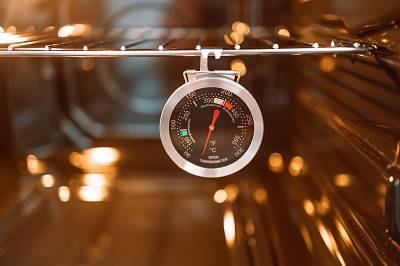 Using a thermometer is a helpful tool when using an oven as a dehydrator, as it can help you monitor the temperature inside the oven and ensure that it stays within the optimal range for dehydration. Here are some tips for using a thermometer when dehydrating food in an oven:
Using a thermometer is a helpful tool when using an oven as a dehydrator, as it can help you monitor the temperature inside the oven and ensure that it stays within the optimal range for dehydration. Here are some tips for using a thermometer when dehydrating food in an oven:
-
Use a food thermometer: A food thermometer is designed to measure the internal temperature of food, and can be used to measure the temperature inside the oven as well.
-
Place the thermometer inside the oven: Place the thermometer inside the oven, close to the food you are dehydrating, to get an accurate reading of the temperature.
-
Monitor the temperature: Check the temperature frequently to ensure that it stays within the optimal range for dehydration, usually between 140-170°F (60-75°C).
-
Adjust the temperature: If the temperature is too high or too low, adjust the oven temperature accordingly to ensure that it stays within the optimal range.
-
Follow the recipe: If you are using a recipe for dehydrating food in an oven, follow the recommended temperature and time settings to ensure that the food is dehydrated properly.
In summary, using a thermometer is a helpful tool when using an oven as a dehydrator, as it can help you monitor the temperature inside the oven and ensure that it stays within the optimal range for dehydration. Use a food thermometer, place it inside the oven, monitor the temperature frequently, adjust the temperature if necessary, and follow the recipe for best results. With these tips, you can achieve great results when dehydrating food in an oven.
Dehydrating Fruits and Vegetables
Time and Temperature Guidelines
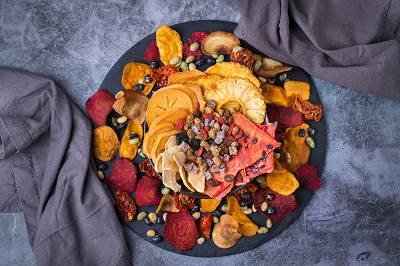 Dehydrating fruits and vegetables requires different time and temperature settings, depending on the type and thickness of the food. Here are some general time and temperature guidelines for dehydrating fruits and vegetables in an oven:
Dehydrating fruits and vegetables requires different time and temperature settings, depending on the type and thickness of the food. Here are some general time and temperature guidelines for dehydrating fruits and vegetables in an oven:
-
Fruits: Fruits are usually dehydrated at a temperature of 140-160°F (60-70°C) for 6-12 hours, depending on the thickness of the fruit. Thinly sliced fruits, such as apples or pears, may take 6-8 hours to dehydrate, while thicker fruits, such as bananas or mangoes, may take 10-12 hours.
-
Vegetables: Vegetables are usually dehydrated at a temperature of 120-140°F (50-60°C) for 6-12 hours, depending on the thickness of the vegetable. Thinly sliced vegetables, such as zucchini or mushrooms, may take 6-8 hours to dehydrate, while thicker vegetables, such as sweet potatoes or beets, may take 10-12 hours.
-
Herbs: Herbs are usually dehydrated at a temperature of 95-115°F (35-45°C) for 1-3 hours, depending on the type of herb and the moisture content. Drier herbs, such as rosemary or thyme, may only take 1-2 hours to dehydrate, while leafy herbs, such as basil or parsley, may take 2-3 hours.
It's important to note that these are general guidelines, and the exact time and temperature settings may vary depending on the type and thickness of the food, as well as the humidity level in your kitchen. It's also important to monitor the food regularly while it is dehydrating, and adjust the time and temperature settings as necessary to ensure that the food is properly dehydrated.
In summary, dehydrating fruits and vegetables requires different time and temperature settings, depending on the type and thickness of the food. Fruits are usually dehydrated at a temperature of 140-160°F (60-70°C) for 6-12 hours, while vegetables are usually dehydrated at a temperature of 120-140°F (50-60°C) for 6-12 hours. Herbs are usually dehydrated at a temperature of 95-115°F (35-45°C) for 1-3 hours. Monitor the food regularly while it is dehydrating, and adjust the time and temperature settings as necessary for best results.
How To Tell When They Are Done
It can be a bit tricky to tell when fruits and vegetables are fully dehydrated, but there are a few things you can look for:
-
Texture: When fruits and vegetables are fully dehydrated, they should be dry and leathery, with no moisture left inside. You should be able to bend them without breaking them, but they shouldn't feel sticky or moist.
-
Appearance: Fully dehydrated fruits and vegetables will usually be darker in color and shriveled up compared to their fresh counterparts. This is because the moisture has been removed from the food.
-
Time: As a general rule, fruits and vegetables that are fully dehydrated will take longer to dry than those that are not. If you've followed the recommended time and temperature guidelines, and your fruits or vegetables are dry to the touch, then they are probably done.
-
Cool-down time: Allow the dehydrated fruits and vegetables to cool for a few minutes before packing them into storage containers. They may still contain some residual heat that could cause moisture buildup in the container.
It's important to note that over-drying can also occur, which can make the fruits and vegetables brittle or even burnt. So, it's important to monitor the food regularly while it is dehydrating, and check on it frequently in the last hour of dehydration. If you're unsure whether your fruits or vegetables are fully dehydrated, it's better to err on the side of caution and remove them from the oven a bit earlier, then continue to dehydrate them if necessary.
Storing Dehydrated Foods
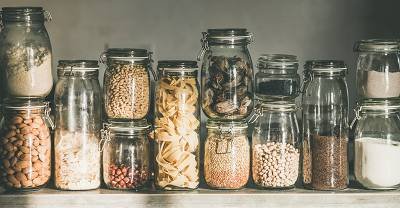 Proper storage of dehydrated foods is important to ensure that they remain fresh and free from moisture. Here are some tips on how to store dehydrated fruits and vegetables:
Proper storage of dehydrated foods is important to ensure that they remain fresh and free from moisture. Here are some tips on how to store dehydrated fruits and vegetables:
-
Cool and dry place: Store dehydrated foods in a cool and dry place away from sunlight, moisture, and heat. A pantry or cupboard is a good place to store them.
-
Airtight container: Use airtight containers such as glass jars, plastic containers with tight-fitting lids, or vacuum-sealed bags to store your dehydrated foods. This will help prevent moisture and air from getting in, which can cause spoilage.
-
Labeling: Label each container with the name of the food, date of dehydration, and the recommended use-by date. This will help you keep track of how long the food has been stored and when it needs to be used by.
-
Rehydration: Before using dehydrated fruits and vegetables, it's important to rehydrate them in water. Soak them in water for a few hours or overnight until they become plump and hydrated. Once they are rehydrated, they can be used in cooking or eaten as a snack.
By following these guidelines, you can store dehydrated fruits and vegetables for several months to a year, depending on the type of food and storage conditions.
Dehydrating Meats and Herbs
Time and Temperature Guidelines
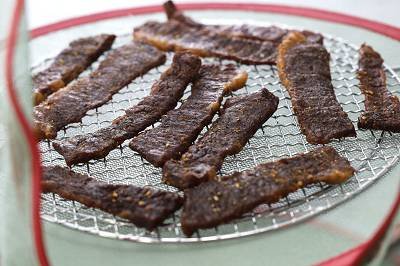 Dehydrating meats and herbs requires a different time and temperature guideline compared to fruits and vegetables due to their different composition. Here are some general guidelines for dehydrating meats and herbs:
Dehydrating meats and herbs requires a different time and temperature guideline compared to fruits and vegetables due to their different composition. Here are some general guidelines for dehydrating meats and herbs:
-
Meats: When dehydrating meat, it's important to first cook it thoroughly to kill any bacteria. Then, slice the meat into thin strips or small pieces, making sure they are of uniform thickness. The recommended temperature for dehydrating meat is between 130-160°F (54-71°C) to prevent bacteria growth, and it usually takes around 4-8 hours to fully dehydrate meat.
-
Herbs: Herbs are much smaller and thinner than meats, so they require a lower temperature and shorter drying time. The recommended temperature for dehydrating herbs is between 95-115°F (35-46°C) and it usually takes around 1-3 hours to fully dehydrate them.
It's important to note that the drying time for meats and herbs can vary depending on factors such as humidity, thickness of the slices, and the type of oven used. It's best to keep an eye on the food while it is dehydrating and check it regularly to ensure that it is drying evenly.
It's also important to use a meat thermometer to ensure that the meat is fully cooked and safe to eat before dehydrating. This will help prevent the growth of bacteria and other harmful microorganisms.
Tips for Successful Dehydration
Here are some tips for successful dehydration of meats and herbs:
-
Choose fresh, high-quality ingredients: The quality of the ingredients you use will affect the quality of the final product. Choose fresh, ripe fruits and vegetables for dehydration, and use high-quality cuts of meat for jerky.
-
Use a sharp knife: A sharp knife will make it easier to slice the meat or herbs into thin, uniform pieces. This will ensure that the food dries evenly and at the same rate.
-
Remove excess fat: When dehydrating meat, remove as much excess fat as possible, as it can become rancid during storage and spoil the meat.
-
Use a marinade: Marinating the meat before dehydrating can add flavor and help tenderize the meat. Make sure to use a marinade that is low in salt, as salt can slow down the dehydration process.
-
Space the food out: When placing the food on the dehydrator trays or baking sheets, make sure to leave some space between each piece. This will allow air to circulate around the food and help it dry evenly.
-
Rotate trays: If using an oven, rotate the trays during the dehydration process to ensure that the food dries evenly.
-
Store properly: After dehydrating, store the food in a cool, dry place in an airtight container to prevent moisture from getting in and spoiling the food. It's also a good idea to label the container with the date of dehydration and the type of food.
Storing Dehydrated Foods
Proper storage of dehydrated foods is important to ensure that they remain safe to eat and retain their quality over time. Here are some tips for storing dehydrated meats and herbs:
-
Cool the food completely: Before storing, make sure the food has cooled completely to room temperature. This will prevent condensation from forming in the storage container, which can cause mold or spoilage.
-
Store in airtight containers: Use airtight containers, such as glass jars with tight-fitting lids, to store dehydrated foods. This will prevent moisture from getting in and spoiling the food. Plastic bags can also be used, but they are not as durable and can be more prone to punctures.
-
Label the containers: Label the containers with the date of dehydration and the type of food, so you can easily identify them later.
-
Store in a cool, dry place: Store the containers in a cool, dry place away from sunlight. A pantry or cupboard is a good option. Avoid storing in the basement or garage, as the temperature and humidity levels can fluctuate.
-
Check regularly: Check the containers regularly for signs of moisture or mold. If you notice any, discard the affected food and repackage the rest in fresh containers.
-
Use within recommended time: While dehydrated foods can last a long time, they can still lose quality over time. Use the food within the recommended time frame for best quality. For example, dehydrated fruits can last up to a year, while dehydrated meats should be consumed within a few weeks to a few months.
Conclusion
Summary of Using an Oven as a Dehydrator
Using an oven as a dehydrator can offer several benefits, including:
-
Cost savings: An oven is a cheaper alternative to buying a separate dehydrator.
-
Convenience: You don't have to purchase and store a separate appliance, which saves space and reduces clutter in the kitchen.
-
Consistency: Ovens offer consistent, even heating which can lead to better results when dehydrating food.
-
Versatility: An oven can be used for a variety of dehydrating tasks, including fruits, vegetables, meats, and herbs.
-
Accessibility: Most people already have an oven in their home, making it a readily accessible option for dehydrating food.
-
Control: With an oven, you have control over the temperature and time, allowing you to customize the dehydration process to meet your specific needs.
Overall, using an oven as a dehydrator can be a convenient, cost-effective way to preserve food and enjoy the benefits of dried fruits, vegetables, meats, and herbs.
Try Dehydrating Your Own Foods at Home.
 Dehydrating food at home is a fun and rewarding experience that can save you money, reduce food waste, and provide you with healthy, nutritious snacks. With an oven, it's easier than ever to try dehydrating your own fruits, vegetables, meats, and herbs.
Dehydrating food at home is a fun and rewarding experience that can save you money, reduce food waste, and provide you with healthy, nutritious snacks. With an oven, it's easier than ever to try dehydrating your own fruits, vegetables, meats, and herbs.
By dehydrating your own food, you have control over the ingredients and can avoid added sugars, preservatives, and other additives that are often found in store-bought dried foods. You can also experiment with different spices and seasoning to create unique flavor profiles that suit your taste.
Dehydrating food is a great way to stock up on seasonal produce and extend its shelf life. You can use your dehydrated foods in recipes or enjoy them as snacks on their own. With a little practice and patience, you can become a pro at dehydrating food and enjoy the benefits of healthy, homemade dried foods.
So, why not give it a try? With an oven and some basic equipment, you can get started on your dehydrating journey today. You'll be amazed at how easy it is and how much you can accomplish with just a few simple steps. Happy dehydrating!
